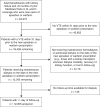Apixaban versus Warfarin for Treatment of Venous Thromboembolism in Patients Receiving Long-Term Dialysis
- PMID: 35470214
- PMCID: PMC9269579
- DOI: 10.2215/CJN.14021021
Apixaban versus Warfarin for Treatment of Venous Thromboembolism in Patients Receiving Long-Term Dialysis
Abstract
Background and objectives: The association of apixaban compared with warfarin for the treatment of venous thromboembolism in patients receiving maintenance dialysis is not well studied.
Design, setting, participants, & measurements: We conducted a retrospective cohort study of Medicare fee-for-service beneficiaries receiving dialysis using United States Renal Data System data from 2013 to 2018. The study included patients who received a new prescription for apixaban or warfarin following a venous thromboembolism diagnosis. The outcomes were recurrent venous thromboembolism, major bleeding, and death. Outcomes were analyzed using Cox proportional hazards regression for intention-to-treat and censored-at-drug-switch-or-discontinuation analyses. Models incorporated inverse probability of treatment and censoring weights to minimize confounding and informative censoring.
Results: In 12,206 individuals, apixaban, compared with warfarin, was associated with lower risks of both recurrent venous thromboembolism (hazard ratio [HR], 0.58; 95% confidence interval [95% CI], 0.43 to 0.77) and major bleeding (HR, 0.78; 95% CI, 0.62 to 0.98) in the intention-to-treat analysis over 6 months of follow-up. However, there was no difference between apixaban and warfarin in terms of risk of all-cause death (HR, 1.04; 95% CI, 0.94 to 1.16). Corresponding hazard ratios for the 6-month censored-at-drug-switch-or-discontinuation analysis and for corresponding analyses limited to a shorter (3-month) follow-up were all highly similar to the primary analysis.
Conclusions: In a large group of US patients on dialysis with recent venous thromboembolism, we observed that apixaban was associated with lower risk of recurrent venous thromboembolism and of major bleeding than warfarin. There was no observed difference in mortality.
Trial registration: ClinicalTrials.gov NCT02664155.
Keywords: ESKD; apixaban; deep vein thrombosis; dialysis; direct oral anticoagulants; end stage kidney disease; warfarin.
Copyright © 2022 by the American Society of Nephrology.
Figures




Comment in
-
Treatment Options for Venous Thromboembolism in Patients Receiving Dialysis.Clin J Am Soc Nephrol. 2022 May;17(5):623-625. doi: 10.2215/CJN.03410322. Epub 2022 Apr 25. Clin J Am Soc Nephrol. 2022. PMID: 35470213 Free PMC article. No abstract available.
References
-
- Virani SS, Alonso A, Aparicio HJ, Benjamin EJ, Bittencourt MS, Callaway CW, Carson AP, Chamberlain AM, Cheng S, Delling FN, Elkind MSV, Evenson KR, Ferguson JF, Gupta DK, Khan SS, Kissela BM, Knutson KL, Lee CD, Lewis TT, Liu J, Loop MS, Lutsey PL, Ma J, Mackey J, Martin SS, Matchar DB, Mussolino ME, Navaneethan SD, Perak AM, Roth GA, Samad Z, Satou GM, Schroeder EB, Shah SH, Shay CM, Stokes A, VanWagner LB, Wang NY, Tsao CW; American Heart Association Council on Epidemiology and Prevention Statistics Committee and Stroke Statistics Subcommittee : Heart disease and stroke statistics-2021 update: A report from the American Heart Association. Circulation 143: e254–e743, 2021 - PubMed
-
- Mahmoodi BK, Gansevoort RT, Næss IA, Lutsey PL, Brækkan SK, Veeger NJ, Brodin EE, Meijer K, Sang Y, Matsushita K, Hallan SI, Hammerstrøm J, Cannegieter SC, Astor BC, Coresh J, Folsom AR, Hansen JB, Cushman M: Association of mild to moderate chronic kidney disease with venous thromboembolism: Pooled analysis of five prospective general population cohorts. Circulation 126: 1964–1971, 2012 - PMC - PubMed
MeSH terms
Substances
Associated data
LinkOut - more resources
Full Text Sources
Medical

